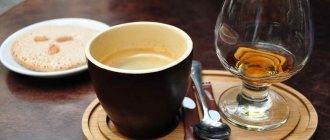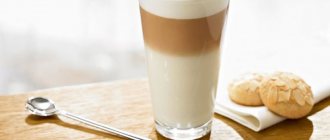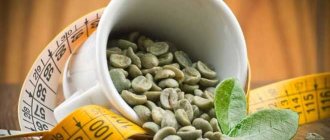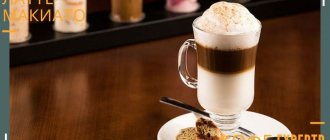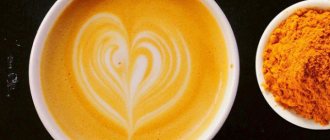A classic latte is a flavored coffee drink with whipped milk, which contains twice as much as espresso. Its name means “milk”.
In addition to its pleasant taste, this cocktail is distinguished by its original three-layer appearance.
Latte is Italian. But in its homeland it is not as popular as in many other parts of the Earth. And residents of some countries are sure that this is their invention. Thus, the French consider the name to be derived from cafe au lait, and the Austrians attribute the authorship to themselves.
In Italy there is a legend about the creation of latte. They say that initially it consisted only of hot milk, into which a small amount of espresso was poured for flavor.
As a result of the collective efforts of Italian baristas, traditional recipes emerged that are known as classics.
Caffe latte: what is it?
Is a latte coffee with milk or milk with coffee? In our opinion, the last statement is more true. And the name of the recipe itself confirms its attraction to the dairy component. “Latte” translated from Italian means “milk”.
- Who and when first made latte coffee is still unknown. Italians attribute the authorship to themselves, rightly emphasizing that the name is Italian. The French claim that they themselves are quite capable of preparing cafe au lait. The Austrians recall that they were the first to mix coffee with milk on the territory of the Austrian Empire.
- There is a popular story in Italy that latte was originally just warmed milk. But one barista decided to add some coffee as a flavoring. This is how the latte coffee recipe came about.
- Whoever came up with the recipe still owes its existence today to Italian baristas. It was through their efforts that the existing classic proportions of latte coffee were established, the basic standards of preparation were established, and the menu of coffee shops around the world adorned the name “Latte”.
Types of latte
Coffee latte, like all the most popular coffee drinks, came to us from Italy. The residents of this country, like no one else, know a lot about it. It’s strange, but in its homeland it is not very popular and, if drunk, it is only in the morning.
The composition of the drink and the distinctive features of its mild taste make it a bestseller in all cafes, bars and restaurants. You can buy it in coffee shops on wheels, take it with you from any establishment, or order delivery. At the same time, the latte coffee recipe is very simple to prepare at home, if you know a couple of secrets.
Latte macchiato
Latte macchiato uses the same ingredients as a classic latte. Black coffee is brewed in the same way and milk is frothed. The milk is then poured into a glass for Irish coffee. Black coffee is poured into the frothed milk in a thin stream.
The specific gravity of coffee is less than that of milk, so the drink in the glass stratifies: the milk settles to the bottom, the coffee sits above it, and on top there is snow-white foam with a speck of coffee: translated from Italian, macchiato means “stained.” The effectiveness of the speck can be emphasized by sprinkling it with chocolate chips.
Ghetto latte
Black coffee and a glass of whipped milk are served separately. The guest himself selects the proportions of the ingredients.
Cinnamon latte
A pinch of powder or a stick of cinnamon is added to the finished drink; it looks especially impressive if served in a special latte mug.
Latte with syrup
There are a huge variety of syrups for the client to choose from. On average, add no more than 20 grams to black coffee before pouring it into the milk-foam mixture. The classic recipe is sugar-free, and the syrup is very sweet, so those with a sweet tooth will like this option.
Important! Fruit syrups can easily spoil a latte with syrup due to the acidic effect on the milk, it will turn sour in a split second. Therefore, vanilla, almond, chocolate or cocoa syrup should be preferred to berry, fruit and citrus syrups.
Vanilla latte
Before heating, you should pour 1-3 drops of natural vanilla extract into the milk and whisk it until it is aromatic. If there is no extract available, regular vanillin will do. Next, the cooking sequence is the same as for the basic recipe. Vanilla coffee drink is enjoyed by children and women.
Caramel latte
This cocktail is essentially prepared with purchased or home-made caramel. It is added to black coffee and mixed thoroughly with it before being poured into the milk-foam mixture.
Autumn recipe
One very unusual and zesty variation of the caramel latte is the pumpkin latte. Perfect for Halloween parties.
In folk medicine, pumpkin is considered a cure for all diseases; moreover, the vegetable has a delicate, pleasant taste. What could be more pleasant and healthier than sitting in a cozy room on a cool autumn evening and drinking a pumpkin latte?
To prepare it you will need:
- pumpkin - 200 grams, cut into pieces;
- clean water - one glass;
- sugar - 100 grams;
- 40 milliliters of black coffee;
- 120 milliliters of milk 3.2% fat.
How to make a pumpkin caramel latte:
- Bake 200 grams of pumpkin, cut into pieces, in the oven at 200 degrees for 30-40 minutes.
- Puree the baked vegetable.
- Pour pumpkin puree into a glass (up to 200 grams) of water, add 100 grams of sugar and gently stir over low heat in a saucepan until the mass thickens.
- Divide the cooked delicacy into small portions (a couple of tablespoons), pour in coffee, then milk, and put foam on top. A large latte cup works best for this type of drink.
- You can decorate with grated chocolate or pumpkin seeds.
Considering how much caffeine this drink contains, people who are sensitive to it in the evening should be careful with this tradition.
Cinnamon latte can also be called autumn; its special feature is that it helps speed up metabolism. Many people still prefer latte according to the classic recipe at all times of the year.
Latte art
A very effective way to serve coffee is latte art. Black coffee is poured into a wide, low ceramic cup. Then they tilt it and carefully add milk.
When the pitcher's spout can be held at a distance of 3-4 mm from the surface of the coffee in the cup, patterns are drawn with milk foam: stylized flowers, leaves, funny little animals. Latte art competitions have been held in the United States since 2014. Late art is the art of painting with milk on coffee.
Composition and proportions of latte
The recipe contains only two ingredients - espresso coffee and frothed milk. Sugar and sprinkles are added as desired.
The soft, creamy taste of the drink and its elegant appearance are ensured by the preparation technology and the proportions of the ingredients. To make a latte, you need one part espresso, two parts milk and one part milk foam. For a classic latte recipe, 200 ml in volume, you will need:
- 50 ml espresso
- 150 ml milk
- 50 ml foam
However, in modern coffee shops there is a tendency to increase portions. The latte grows in volume to 300-400 ml. One would expect a simple increase in the serving size while maintaining the proportions, but in reality the serving of milk increases, and the coffee remains almost the same amount.
Latte coffee recipe
How to make a latte? The recipe, although simple, requires some skill.
First, prepare a 35-50 ml portion of espresso.
Then take milk for whipping. If you do not carefully monitor your calorie consumption, then take a product with a fat content of 3.5%. With it, coffee will have a silky and delicate taste. Skim milk makes lattes watery. The volume of milk should be 200 ml for the classic recipe, as part of the product will turn into that delicious foam for which we love lattes.
Some gourmets and gourmands really appreciate the delicate, sweetish taste of latte, made from a mixture of cream and milk in proportions of 1/1. Mix the cream and milk before whipping.
Whisk the milk until a coarse foam appears. For a latte, the foam should be loose, oxygenated, and bubbly. It is important not to beat the foam, otherwise it will become too dense.
Pour milk and foam into a tall cup or latte glass. Then carefully, in a thin stream, pour in the finished coffee along the wall. As a result, the foam cap remains on top, and the coffee is mixed with liquid milk. The drink is ready, you can serve it.
More recently, baristas have gone to great lengths to ensure that lattes maintain their flaky texture. Of course, visitors liked the alternation of milk and coffee so much! But windy fashion has changed the requirements. Nowadays the trend is democratic simplicity and emphasized minimalism, without excessive decoration. Therefore, today's fashionable latte has a homogeneous structure, to obtain which the drink can be stirred.
Classic latte recipe
- Prepare a standard shot of classic espresso;
- Whisk 150-170 ml of milk in a pitcher using steam. At the same time, latte foam should be more fluffy and airy than cappuccino foam;
- Pour the frothed milk into a glass, then slowly pour the espresso into it in a thin stream.
If the whole procedure is carried out carefully, the layers of coffee and milk will not mix and you will get a delicious layered coffee cocktail. It is sometimes also called latte macchiato (also pronounced latte macchiato, latte macchiato, etc.). If the frothed milk is at the right consistency and the espresso is at the right temperature, the layers should separate clearly. It is the clear separation of the three layers that is considered the first indicator of the quality of a latte macchiato. If you do not have enough experience or do not have professional utensils and accessories to separate layers of foam, milk and espresso, you can use a spoon.
Coffee latte recipe at home
For a quick latte, it's best to have an automatic coffee maker on hand. If you are planning to treat yourself to a delicate drink, but have not yet acquired a coffee machine, then especially for you we will tell you how to make latte coffee at home.
What will you need?
- Strong coffee brewed in a cezve, geyser coffee maker, or even infused in a French press. Proportions – 2 heaped teaspoons per 80 ml of water. After preparation, be sure to strain so as not to spoil the pampered structure of the future drink.
- Milk for whipping. At home, you will have to beat with a whisk, blender or mixer; to obtain foam you will need a product with a fat content of at least 3.2%. Otherwise you won't get good foam. If you are not afraid of extra calories, but are afraid of unstable foam, then feel free to take a mixture of cream and milk in proportions 1:1. In total you need 200 ml of milk or creamy milk mixture.
- Sugar and other sweet bonuses - to taste.
How to cook?
- First, prepare and filter the coffee, measure out 50 ml. We set it aside.
- Lightly heat the prepared milk in the microwave, to approximately 30-40 degrees.
- Beat the heated milk at high speed for 3-4 minutes. A signal that you have achieved your goal will be the formation of airy, porous foam on the surface of the milk.
- Heat a tall cup or glass goblet in the microwave.
- Pour milk with foam into a cup.
- Carefully pour in the coffee, you can use a knife blade.
- Spread the remaining foam onto the surface of the drink using a spoon.
- Your homemade latte is ready.
The quality and taste of the latte depends on the quality of the milk and whipped foam; there is little coffee in the recipe, so its bouquet is weak. If we talk about the most suitable coffee for latte, then it is best to use soft Arabica varieties or a mixture with a minimum content of Robusta.
Latte macchiato recipe
Ingredients:
- 60–70 ml espresso;
- 180 ml fat milk;
- sugar, grated chocolate, ground cinnamon, cocoa powder - to taste.
Cooking technology
- Whisk the milk.
- Brew a double shot of espresso in the coffee machine.
- If necessary, dissolve sugar in coffee.
- Pour the milk into a preheated glass glass or mug.
- Slowly pour in the coffee in a very thin stream. There should only be one small coffee stain on the surface of the milk foam.
- Decorate the spot with grated chocolate, cinnamon or cocoa powder.
The specific gravity of hot coffee is less than that of full-fat milk. Therefore, when added, the coffee does not sink to the bottom and does not mix with the unwhipped milk. Since fluffy milk foam is even lighter, it remains on the surface.
You can add vanilla sugar to the milk before whipping, and decorate the foam on top with thin strips of chocolate or caramel syrup. If you dissolve 1-2 teaspoons of condensed milk in coffee, the drink will not look as impressive, but the creamy taste will increase. You cannot add alcohol to coffee, otherwise the milk will curdle.
For latte macchiato, you need a thick-walled glass: while the drink remains hot, the layers will not mix.
Latte coffee calories
The nutritional value of a coffee latte directly depends on the amount of milk used for preparation, its fat content and sweet additives in the recipe - sugar, sprinkles, topping.
- A 250 ml serving of latte, prepared using milk with a fat content of 2.5%, has a calorie value of 109-110 kcal.
- The same serving with 3.2% fat milk contains 116-118 kcal.
- Each teaspoon of sugar added to a latte increases calories by 20 kcal.
- A latte made from a mixture of 10% cream and milk with a fat content of 2.5% has a calorie content of 175 kcal, and with two tablespoons of sugar the nutritional value of the drink will increase to 215 kcal.
For latte coffee, the portion of which exceeds the classic 250 ml, the calorie content increases in proportion to the increase in the amount of milk.
Latte ingredients
To enjoy your favorite drink, you must have the following products in your kitchen:
- ground coffee - 3-4 teaspoons (another amount if taste requires it);
- sugar - 1 teaspoon (or to taste);
- water for making espresso – ¼ glass;
- milk – ½ glass;
- high fat cream;
- salt on the tip of a knife.
Serving rules: glasses and cups for latte
The popularity of the latte recipe prompted glassware manufacturers to come up with special glasses and cups for this recipe.
- Latte glasses are made of transparent glass, have a cone shape and a thickened bottom. A few years ago they came with a handle and stand. Unlike Irish glasses, latte glasses did not have a leg; the stand was attached directly to the bottom. Today's trend towards minimalism and laconic forms has given rise to a new generation of latte glasses. They look like ordinary tall glasses in the shape of a truncated inverted cone. Perhaps the thickness of the glass and the impressive bottom indicate that hot drinks are drunk from these glasses.
- After the trend for “striped” lattes passed, coffee began to be served not only in glass glasses, but also in cups. It is believed that latte cups do not look as formal and formal as glass glasses. Cone-shaped latte cups have an impressive volume of up to 400 ml. They can be equipped with a handle or silicone holders that are located along the diameter of the cup.
Long-handled spoons for stirring the drink are often sold along with latte cups. The large volume of dishes does not allow the use of ordinary teaspoons.
Serve the latte hot, without waiting for it to cool. Cups are placed not on saucers, but on special coasters.
Properly frothing milk for lattes and cappuccinos
If we use a coffee machine, we prepare the equipment in advance:
- Steam pipe. She needs to let off steam.
- A pitcher is a metal container in the shape of a jug, used in creating foam. The device connects to the steam wand on the coffee machine.
- Cappuccino maker for creating milk foam. Nowadays they mainly use the most common attachment, the Panarello cappuccino maker.
Cappuccino makers have 2 types:
- steam, with the spray principle;
- mechanical, with torsion of the rims.
What is the difference between a latte and a cappuccino?
This question often occupies fans. The ingredients of the drinks are the same - coffee and milk, optionally sugar. So, maybe this really is the same coffee, just under different names?
We hasten to disappoint fans of simplifications - latte and cappuccino are different drinks. We have already talked in detail about their main differences in one of the previous articles, so we will only note the key points on which the recipes differ.
- Proportions . A cappuccino is made from one part coffee and two parts milk, and a latte is made from one part coffee and four parts milk. Therefore, latte has a much higher milk content.
- Cooking method . To prepare a cappuccino, milk is poured into the prepared coffee, while for a latte, on the contrary, coffee is poured into frothed milk.
- Foam quality . Lattes are decorated with loose, porous foam. For cappuccino, whip up a denser, silkier, uniform foam with fine bubbles. To obtain such foam, the milk needs to be whipped longer than for a loose “cap” of a latte.
- Caffeine content per 100 ml . For cappuccino, take more coffee, up to 100 ml per 200 ml of milk. For latte, a portion of 50 and sometimes 30 ml is prepared. Therefore, a latte is much less strong than a cappuccino.
So, a cappuccino contains more espresso than a latte, it is stronger and its taste is more expressive. The cappuccino foam is denser and smoother. Latte contains less espresso, its taste is milky, delicate, sweetish, silky, and the foam is loose and airy.
How to beat
- Milk is poured into the so-called jug (pitcher), only 1 cm less than the height of the spout itself. Because when whipping, the volume of liquid increases.
- Place the tip of the cappuccino maker at 45 degrees next to the wall of the pitcher. It looks away from the center of the milk jug, with a depth of 1 cm.
- After the end of the cappuccino maker is immersed, the machine is turned on and steam pressure is applied. In order to know the temperature of the milk, the pitcher must be held by the bottom.
- Watch the sound when lowering the cappuccino maker.
After we feel the warm bottom of the pitcher, we move on to the next stage:
- The nozzle is immersed to a height of 1 cm from the bottom of the pitcher. You will immediately feel the disappearance of hissing.
- The handle helps you hold the pitcher. Because milk heats up to 75 degrees. Can't go any higher.
- Turn off the steam supply. Pull the nozzle out of the milk.
- To obtain a uniform consistency, shake the jug and lightly tap it on the table surface.
How to drink latte correctly
Latte drinking habits have changed over the past few years.
Previously, lattes were served in glass glasses with a straw through which you had to drink coffee. The style of serving and drinking lattes was more reminiscent of cocktails in bars.
Now both serving and drinking lattes have become more democratic. The layered structure of the drink is no longer in fashion. Glass glasses with straws give way to tall cups with funny inscriptions. The straws have been replaced by spoons with a long handle, with which you can safely stir up your latte and drink coffee like a regular hot drink.
Timing your latte is important. According to Italians, this is a drink for the first half of the day. In the Apennines, coffee with milk is consumed until 11 o'clock. Drinking lattes and other milk-containing recipes later is thought to disrupt digestion. In any case, latte is never drunk after a meal, but only between meals. The only exception is breakfast, during which you can indulge in a cup of latte.
Briefly about the history and name
There is a great temptation to emphasize the last syllable in the name of a coffee and milk drink; after all, the French version is closer to us. It is not for nothing that for centuries our great-great-grandmothers conducted conversations only in French and preferred trips to Paris over other cities of old Europe. The desire for aristocratic chic forced the emphasis in words to be placed more often on the last syllable, as required by the rules of French linguistics.
But let's not succumb to the charm of a country that has nothing to do with the invention of latte coffee. Its homeland is Italy, and on its territory the drink is called Latte. Let's show respect to child-loving Italians! After all, they were the pioneers of the latte brand.
With their light mother's hand, coffee combined with milk. Family Italian traditions require the whole family to meet at the same table for breakfast and dinner. But for the restless children of sunny Italy, caffeine consumption was undesirable even in the morning. Therefore, mothers began to dilute their servings of traditional coffee with a significant dose of milk (latte in Italian). And everyone was pleased! The children were calmer, and the world received a magnificent, delicate cocktail.
Literally translated, café latte is “coffee with milk.” It’s just that, unlike an ordinary and familiar drink, the milk needs to be frothed.
Latte art: how to apply?
Latte art is a technique for creating patterns on the surface of coffee using coffee and milk foam.
Latte art is much more common on cappuccino cups than on lattes. The dense foam of a cappuccino is better suited for drawing than the loose and airy surface of a latte. In addition, cappuccino is not stirred, unlike lattes.
If you are served a latte with drawn patterns, it means that you will drink the coffee through the foam without stirring. However, if you are determined to put sugar in your latte and stir the coffee, then you can safely do this by admiring the pattern on the surface. This will not be a violation of the rules.
Best Latte Milk Brands for 2021
In 2021 , you can find a variety of milk brands on store shelves, which differ significantly both in price and taste. In order to make milk-based coffee, you need to choose the right dairy product. There are three categories of milk: expensive, average and cheap. The best milk choices are the Valio and Domik v Derevny brands. The milk from these brands has a rich flavor and is ideal for making lattes. The foam is thick but light, which is so important, because latte is a drink with a high milk content. Many baristas call Valio milk the best choice in 2021 .
